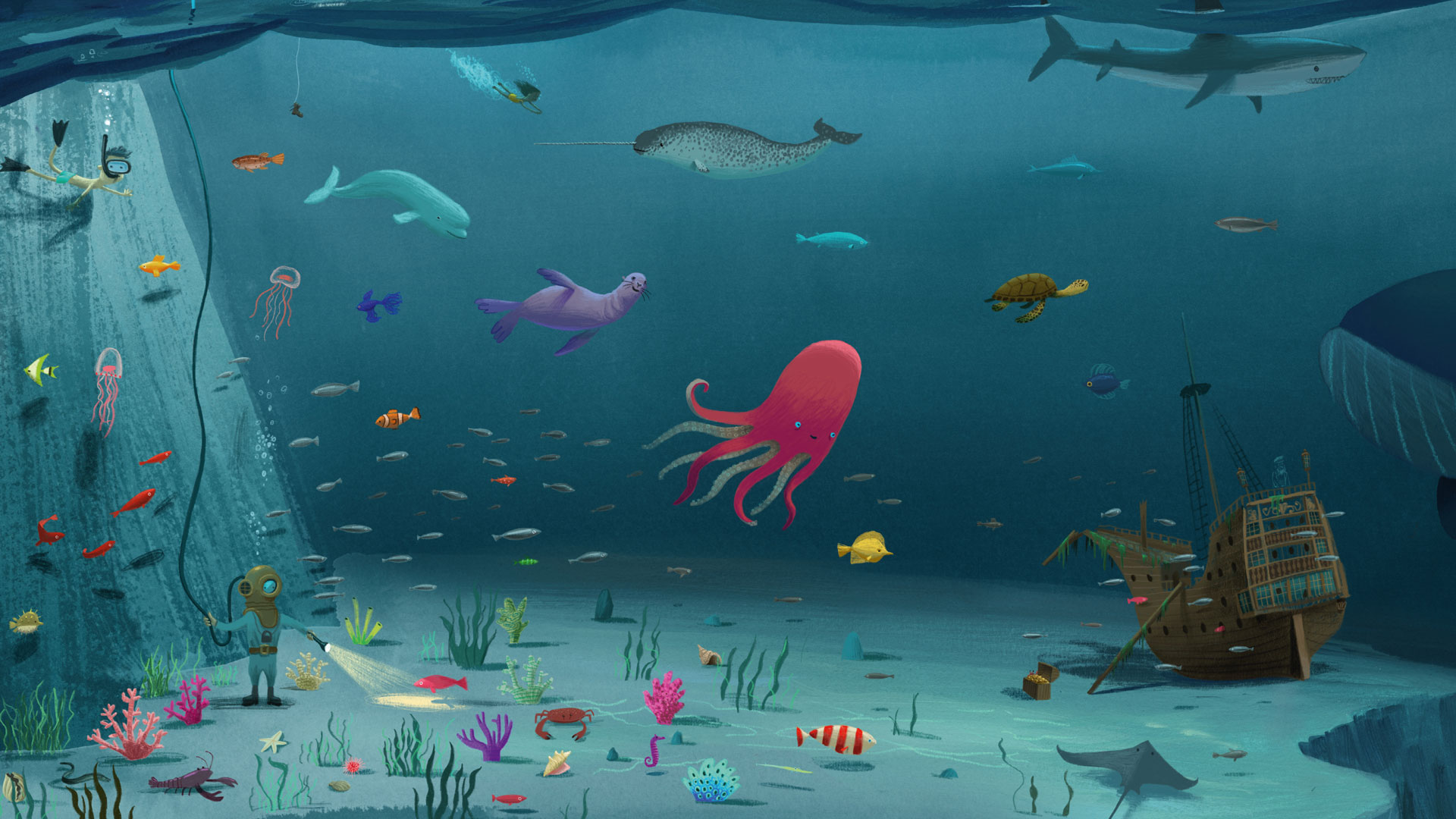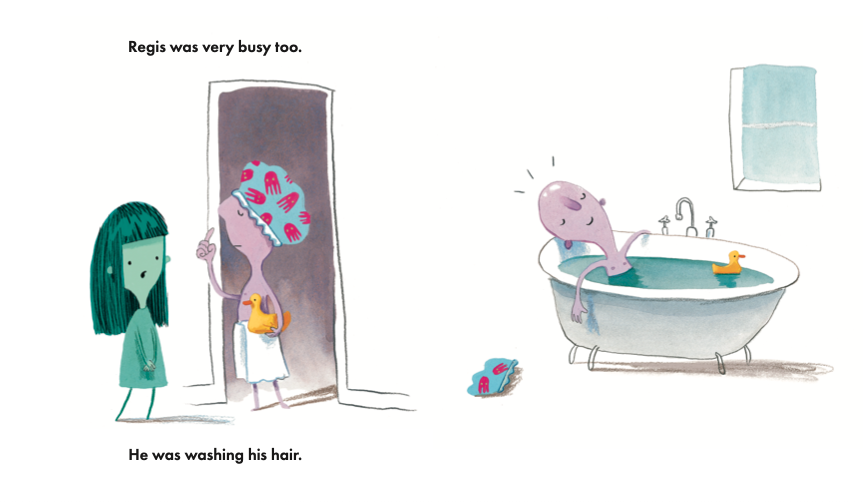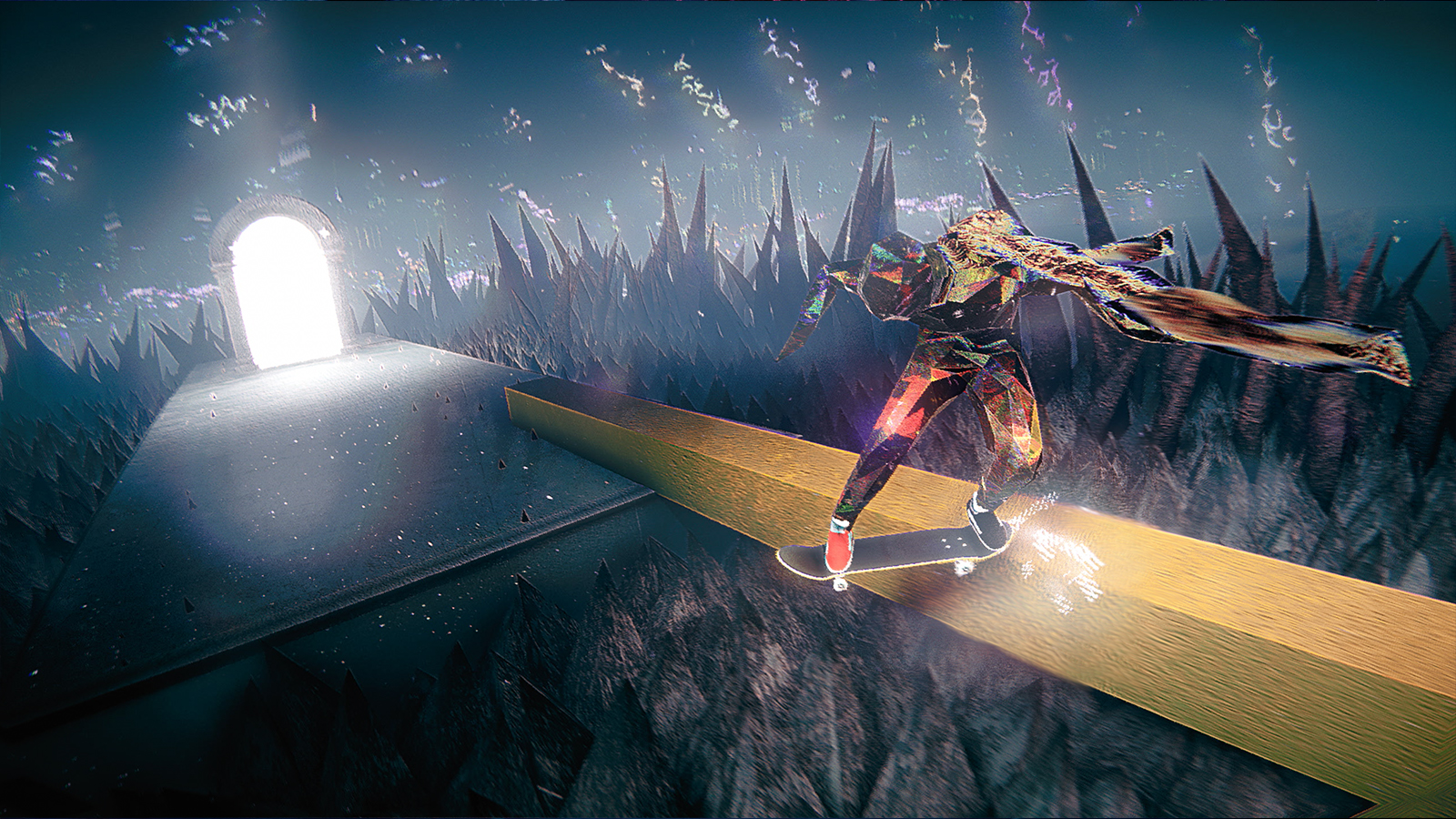"Why don't I do a fish-mas tree?" Oliver Jeffers on his charming new project for Apple
I speak to the picture book maker about his Christmas-themed projection.

Famed picture book illustrator Oliver Jeffers is known for his warm-hearted, beautifully illustrated books, some of which contain a social or political message.
I had spoken to him previously about his book The Dictionary Story so it was lovely to chat again. This time we were discussing the fish-mas tree that he created for Apple, to be projected onto Battersea Power Station along with artwork by other famous names, including Sir Stephen Fry and David Shrigley OBE. Our conversation also touched on his distinctive handwriting, his process and how he creates books based on feelings rather than characters or colour palettes.
I asked Oliver what had drawn him to this project with Apple. "It's keeping good company, David Hockney did the first one, Aardman last year. And Battersea is such an iconic building that it just felt like a good thing to be associated with," he said, before adding that Apple had supported him for a number of years on his climate change work.
The idea for a fish-mas tree is based on an underwater spread in his acclaimed book Here We Are (above), which inspired both an Emmy-winning animated film and an installation that's currently showing at the Brooklyn Museum in New York, called Life at Sea.

"The health of our planet depends on the health of the oceans. And at the current rate, the oceans are going to be devoid of life. They're empty and that's catastrophic for everybody," said Oliver. "So the installation begins with that, and then with the idea that to build a future that we want, we have to imagine at first.
"In this fun and family friendly, interactive, immersive insulation, people are encouraged to come along, and add a piece of sea life to this barren, empty seascape. And the idea is that over the course of the installation, it becomes this abundant teeming with life oceanscape that's the opposite of when it started."
Oliver explains that all this led him to have fish "at the front of my mind", so when he was asked to design a Christmas tree, he immediately thought, 'I should do something with fish. Why don't I do a fish-mas tree?'
Daily design news, reviews, how-tos and more, as picked by the editors.
A post shared by Oliver Jeffers (@oliverjeffers)
A photo posted by on
"The concept lent itself to a skinny triangle, and then just really, it's getting into the weeds of it. What would be at the bottom? Obviously, a whale. What would be at the top? What's the smallest fish I could think of that you can see? Probably a sardine.
"And then playing with different ways to continue the analogy. Maybe there could be shrimp lights and then obviously it should be topped with a starfish. And then some jellyfish ornaments."
And then, rather than having string wrapped around his tree, Oliver had the idea of using seaweed. "It was just a matter of playing and having a bit of fun with it," he said, adding that his seven-year-old daughter also helped him colour in some of the shapes.
The trickiest thing was not getting too detailed
In terms of process, Oliver always starts with pencil and paper "'cos I'm so used to thinking like that". In this instance, he drew some rough shapes, then photographed them to bring in as a template. He then moved onto the iPad, using Procreate.
"The trickiest thing was not getting too detailed, because it's easier to just keep zooming in and working in detail. But you just realise once you can see the pixels and you're doing a detail that's a single pixel that nobody's going to see this, so what’s the point?"
Oliver is used to using the iPad for work. "It's so much easier to make art using Procreate on the iPad while on the move, whereas before I would have had to have been in my studio and drawn something or painted something on a piece of paper and taken a photograph to post," he said.

Not only do Oliver's books feature his exquisite artwork, they also feature his very distinctive handwriting. Does he ever write directly on the iPad? "I can, but for the books, I think there's something about the particular pencils that I use that cannot really be created digitally.
"So when I'm making a book, I do a placeholder in the iPad, just so I know roughly where it is, but when it's going to print, I redo the handwriting on paper and scan it in, clean it and drop it in," said Oliver. He also added that for social media posts and things that are "a little more spontaneous," he would absolutely just write on the iPad in Procreate.
I asked Oliver a little more about his handwriting. Did he develop it or has he always had it?
"I've always had that handwriting. I definitely turn the volume up on it a little bit when I know that other people are gonna see it, but whenever I'm at book signings and I write somebody's name or whatever it is, they're like, ‘Oh my gosh, it's your handwriting’. I’m like, ‘well, of course, it's my handwriting’.
It took a long time technically to get there
"In the early art that I was making, I always liked having type in there as a sort of a focal device that could lend some degree of a hierarchy of visual language, where you would read the word first, and then you would go to the image. So it creates this sort of tonal focus in a piece of art. So I've always enjoyed what conceptually lettering did to an artwork."
But transposing his handwriting from paper to book pages hasn't always been easy. "I couldn't figure out how to handwrite in a way that was scanned that could be treated so it actually looked like my handwriting, 'cause I didn't really understand Photoshop," said Oliver. "Trying to photograph and scan pencil is notoriously tricky, 'cause it's slightly reflective.
"It wasn't until later on that I realised that writing in coloured pencils or charcoals and then scanning them and cleaning them up, myself in Photoshop actually worked, so it took a long time technically to get there."

I wondered whether Oliver had developed a style that he thought children would engage with, and he said that he didn't try and do that at all. "It just so happens that there's a degree of simplicity to a lot of things that I do, and children seem to enjoy that."
"I think I share a sense of humour with most five to eight year olds, but there was no thinking, ‘What do I think kids would like?’ and then leaning into that. I've realised – doing this now for a long enough time – that if you try to just be as honest with yourself as possible, that lets people in.
"If you try to make a concept simple enough that any adult could get it and any child could get it, that is both effective at making political art or art about the state of the world, but also very, very useful and accessible for simple picture books. So it is, I can't necessarily say by design, and it's also not necessarily by accident, but it's somewhere in between. The way in which I think and the way in which I draw lend themselves to this."

Oliver's work is known for its rich storytelling, well developed characters and beautiful imagery. I asked him what comes first when he's thinking about a new project – story, character or illustration.
"None of those things," he said. "The way I explain it to kids, is it's a feeling first. When I ask them 'do you remember a dream? And if you go to describe that dream, where do you go to, which comes first, when you're going to describe that dream?' They find it tricky to answer to that question, because really it's a feeling, and so it's the same thing with an idea.
Ideas come in the form of a concept and a feeling
"When ideas come, they come in the form of a concept and a feeling, and then through trying to find out what that idea is, you dig down into it." Story and character follow, he added, but they've got to feel right for the feeling.
"Concepts are flashes of feelings and the entire process of creation is trying to not stray too far from that original feeling that you had.
Is it possible to capture that feeling exactly? "No project has ever turned out the exact way that I thought it would at the moment of inception," said Oliver. "It's a bit like a heat-seeking missile. You adapt to what happens in front of you."
Oliver Jeffers' latest book I'm Very Busy: A (Nearly Forgotten) Birthday Book is out now. Stay tuned to read more about it in the second part of our interview, coming soon to Creative Bloq.

Rosie Hilder is Creative Bloq's Deputy Editor. After beginning her career in journalism in Argentina – where she worked as Deputy Editor of Time Out Buenos Aires – she moved back to the UK and joined Future Plc in 2016. Since then, she's worked as Operations Editor on magazines including Computer Arts, 3D World and Paint & Draw and Mac|Life. In 2018, she joined Creative Bloq, where she now assists with the daily management of the site, including growing the site's reach, getting involved in events, such as judging the Brand Impact Awards, and helping make sure our content serves the reader as best it can.
You must confirm your public display name before commenting
Please logout and then login again, you will then be prompted to enter your display name.
